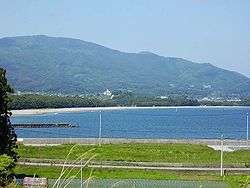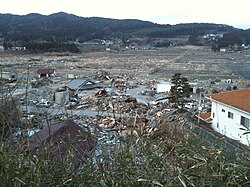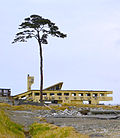Rikuzentakata, Iwate
Rikuzentakata (陸前高田市, Rikuzentakata-shi) is a city in Iwate, Japan.
|
陸前高田市 | |
|---|---|
City | |
 | |
 Location of Rikuzentakata in Iwate Prefecture | |
| Coordinates: 39°01′40.9″N 141°37′31.5″E / 39.028028°N 141.625417°ECoordinates: 39°01′40.9″N 141°37′31.5″E / 39.028028°N 141.625417°E | |
| Country | Japan |
| Region | Tōhoku |
| Prefecture | Iwate |
| Government | |
| • -Mayor | Toba Futoshi |
| Area | |
| • Total | 231.94 km2 (89.55 sq mi) |
| Population (April 1, 2017) | |
| • Total | 19,666 |
| • Density | 83.7/km2 (217/sq mi) |
| Time zone | UTC+9 (Japan Standard Time) |
| City symbols | |
| - Tree | Cryptomeria |
| - Flower | Camellia |
| - Bird | Common gull |
| Phone number | 0192-54-2111 |
| Address | 110 Tatenooki, Takatachō, Rikuzentakata-shi, Iwate-ken 029-2292 |
| Website | http://www.city.rikuzentakata.iwate.jp/ |
The 2010 census counted 23,302 people living in the city. (2005 showed 24,709).[1] The city was founded on January 1, 1955. Much of the city was heavily damaged by the 2011 Tōhoku earthquake and tsunami.
Geography
The area of the city is 232.29 km² and the population density is 100 people per km².
Politics and government
The mayor of the city is Futoshi Toba.
Industry
As of 2011, oyster farming produced ¥40 million in annual sales for the city.[2]
Transportation
There is one railroad line with six stations in Rikuzentakata.
2011 Tōhoku earthquake and tsunami effects
Rikuzentakata was reported to have been "wiped off the map" by the tsunami following the Tōhoku earthquake.[3] According to the police, every building smaller than three stories high has been completely flooded.[4] Buildings taller than three stories were partially flooded. At the city hall, water also reached as high as the third floor.[5]
On 14 March, a BBC report showed a picture of the town. The report described the city as "almost completely flattened." Reporters could not tell how many people had survived.[6] The city did have tsunami shelters. The shelters were designed to protect people from a wave 3 to 4 meters tall. However, the tsunami of March 2011 was 13 meters high in the city. The wave covered the areas that were supposed to be safe.[7] Local officials estimate that 20% to 40% of the cities people died. "Rikuzen-Takata effectively no longer exists."[8] The city had a 6.5 meter high seawall, but it was not enough. More than 80% of 8,000 houses were destroyed by the tsunami.[9]
As of 3 April 2011, 1,000 people from the town were confirmed dead with 1,300 still missing.[10]
Sixty-eight city officials, about one-third of the city's municipal employees, were killed. The town's mayor, Futoshi Toba, was at work at the city hall and survived. His wife was at their seaside home and she died.[11]
Takata-matsubara
Takata-Matsubara (高田松原) is part of the coastline, two kilometers long. About seventy thousand pine trees used to grow there.[12] It was selected as one of the 100 Landscapes of Japan (Shōwa period) in 1927 and in 1940 it was named a Place of Scenic Beauty.[13][14] After the 2011 tsunami only one tree was still there. A single, ten-meter tall, two hundred year-old tree is all that is left from the forest. The tree is only five meters from the sea and may be damaged by too much salt. The Association for the Protection of Takata-Matsubara along with the city and prefectural governments are trying to protect the last pine tree.[12]
Rikuzentakata, Iwate Media
References
- ↑ "2010 census". Ministry of Internal Affairs and Communications. Retrieved 29 April 2011.
- ↑ Matsuyama, Kanoko, and Stuart Biggs, (Bloomberg L.P.), "Tsunami - insult to injury", Japan Times, 30 April 2011, p. 3.
- ↑ Staff Reporter (12 March 2011) "Wiped off the map: The moment apocalyptic tsunami waves drown a sleepy coast town". www.dailymail.co.uk, Retrieved 12 March 2011
- ↑ "Honderden doden in Japanse kuststad (Hundreds dead in Japanese coastal town)" (in Dutch) Archived 2011-04-07 at the Wayback Machine. www.rtlnieuws.nl, Retrieved 12 March 2011
- ↑ Kyodo News, "Deaths, people missing set to top 1,600: Edano", Japan Times, 13 March 2011.
- ↑ BBC News – World "Japan earthquake: In pictures" Picture 6 of the series
- ↑ http://www3.nhk.or.jp/daily/english/28_04.html Archived 2011-08-10 at the Wayback Machine NHK News Report says March 11th tsunami confirmed up to 13 meters high, 28 March 2011
- ↑ Tsunami preparation leads citizens into low-lying death traps.https://www.theglobeandmail.com/news/world/asia-pacific/tsunami-preparation-leads-citizens-into-low-lying-death-traps/article1943381/
- ↑ ShelterBox Response Team operational in Iwate Prefecture Archived 2011-05-20 at the Wayback Machine News update from charity ShelterBox, 22 March 2011
- ↑ Ito, Shingo (Agence France-Presse/Jiji Press), "Iwate pine that withstood the wage now symbol of hope", Japan Times, 3 April 2011, p. 3.
- ↑ Agence France-Presse/Jiji Press, "Mayor perseveres amid his loss", Japan Times, 13 April 2011, p. 3. Toba's two children were at school and survived.
- ↑ 12.0 12.1 Asami, Toru (18 April 2011). "Battle to protect sole surviving pine tree". Daily Yomiuri. http://www.yomiuri.co.jp/dy/national/T110417002437.htm. Retrieved 5 May 2011.
- ↑ "日本八景(昭和2年)の選定内容" (PDF). Ministry of the Environment. Retrieved 17 March 2011.
- ↑ "Database of Nationally-Designated Cultural Properties etc". Agency for Cultural Affairs. Archived from the original on 27 November 2011. Retrieved 5 May 2011.
Other websites
| Wikimedia Commons has media related to Lua error in Module:Commons_link at line 62: attempt to index field 'wikibase' (a nil value).. |
- (in Japanese) Rikuzentakata official website
- Gala day procession with floats, August 2010 Five videos available in this series
- The tsumani sweeping over Rikuzentakata
- Al Jazeera report on Rikuzentakata after the waters receded
- Rikuzentata as the rescue begins Mark Willacy reports for ABC News
- Tsunami Damage, Rikuzentakata (March 2011) Before-and-after thermal satellite images from NASA
- The floodgate that didn't work to stop the tsunami BBC report on the failure of the Rikuzentakata floodgates




